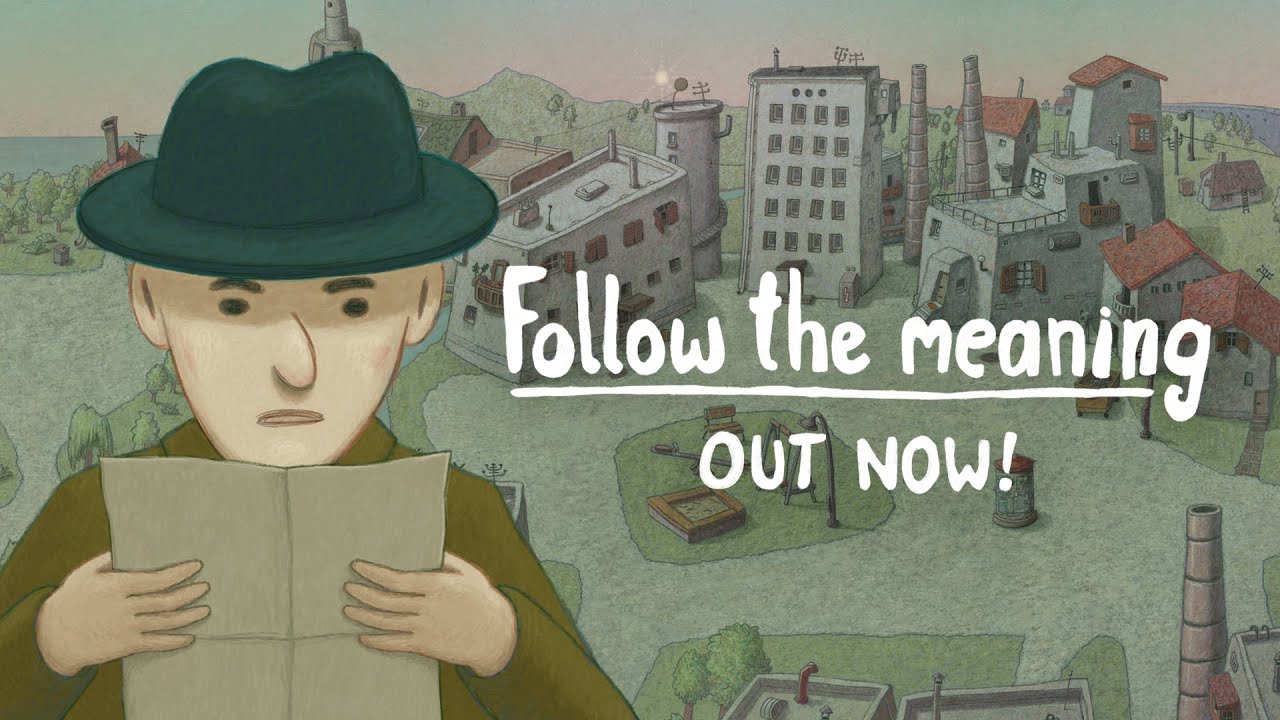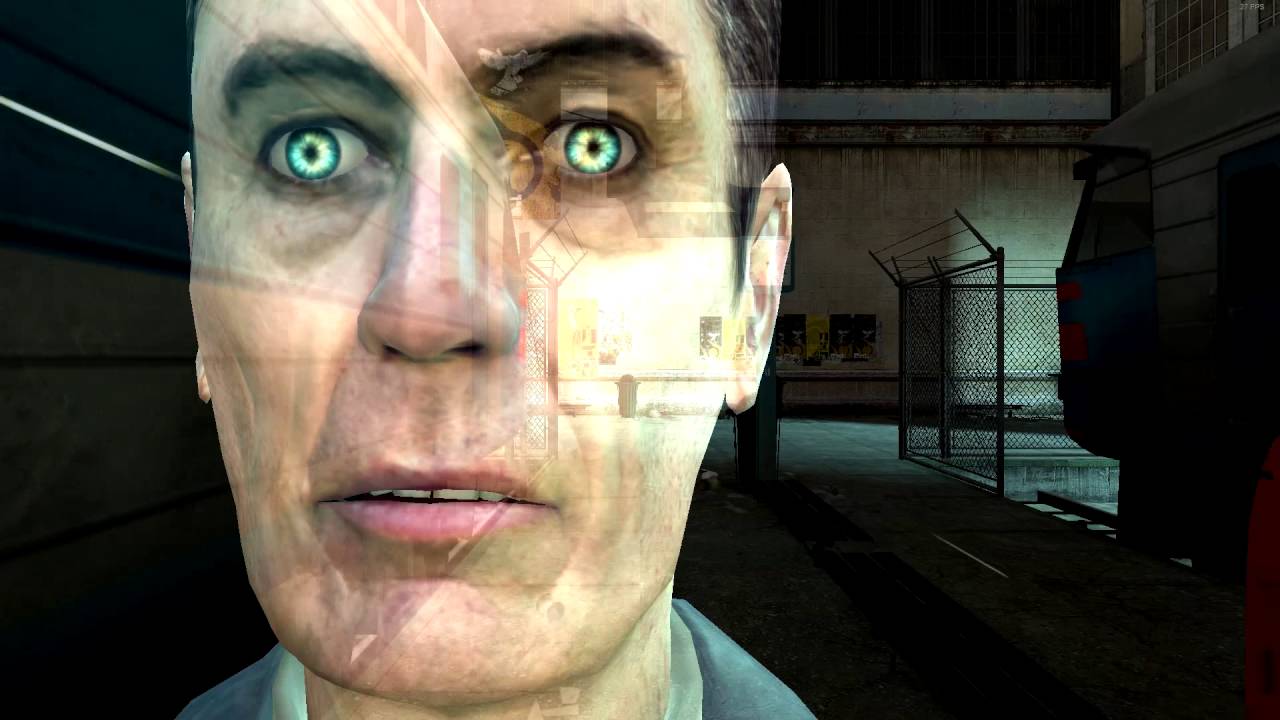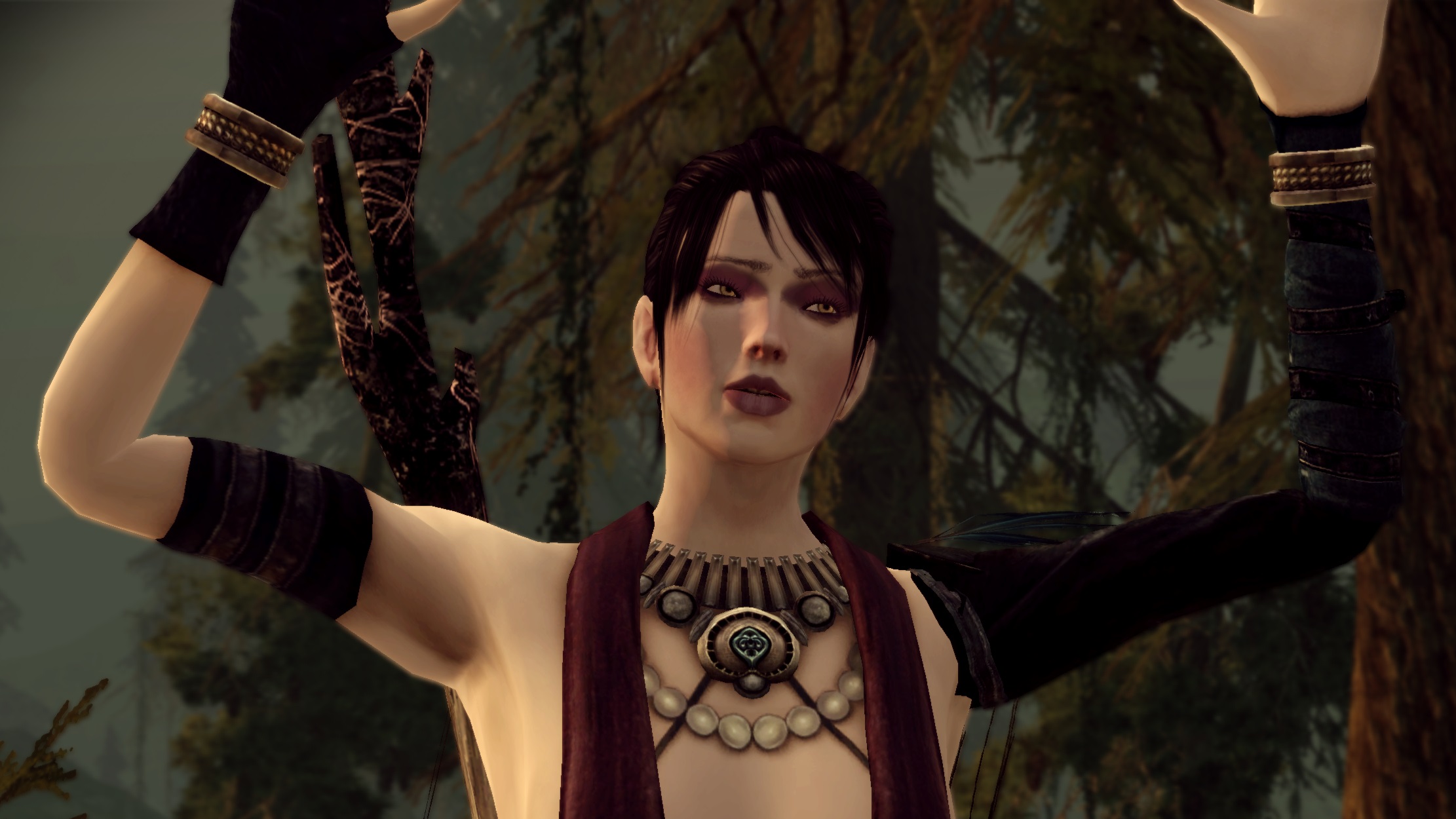
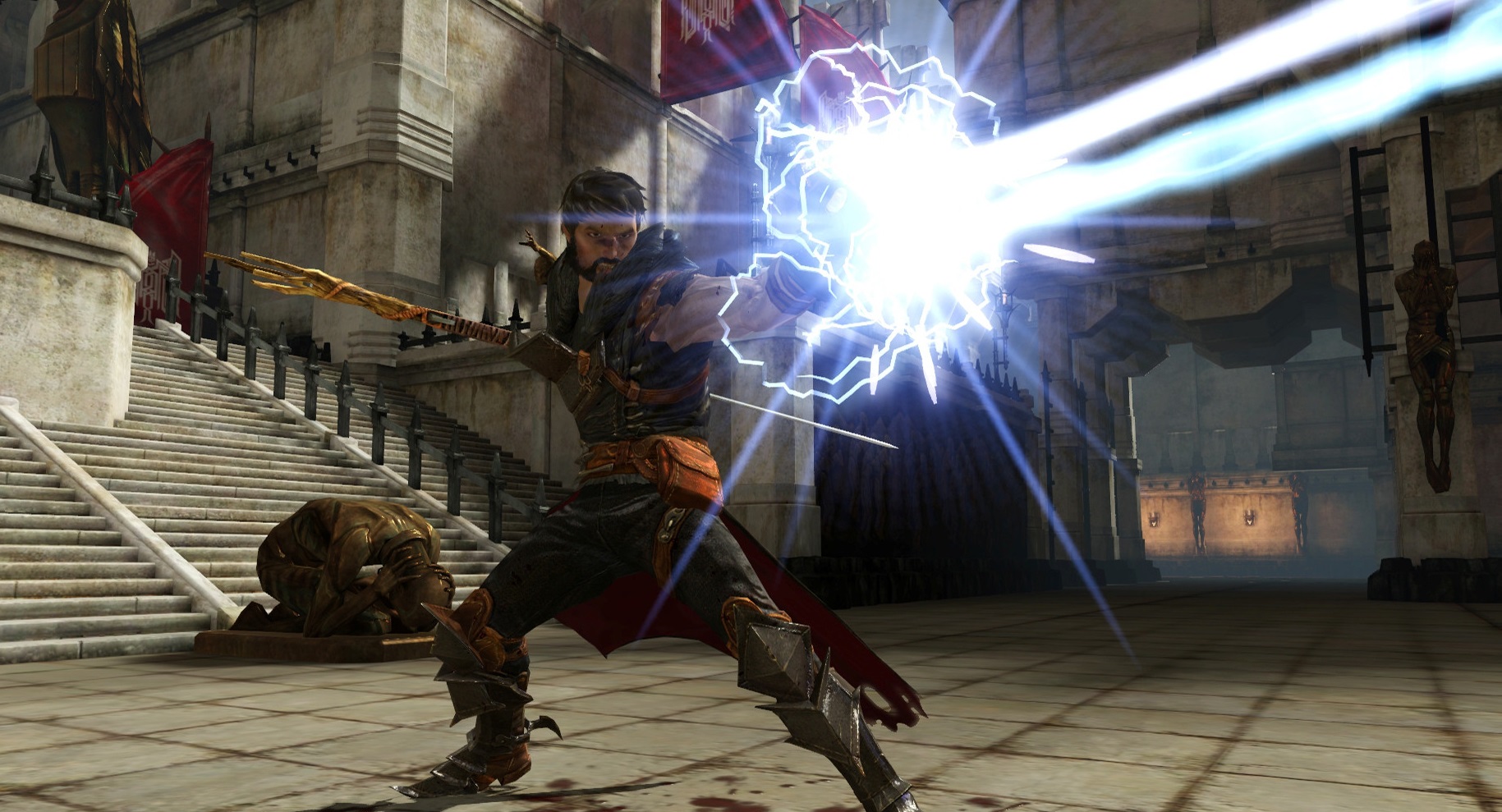
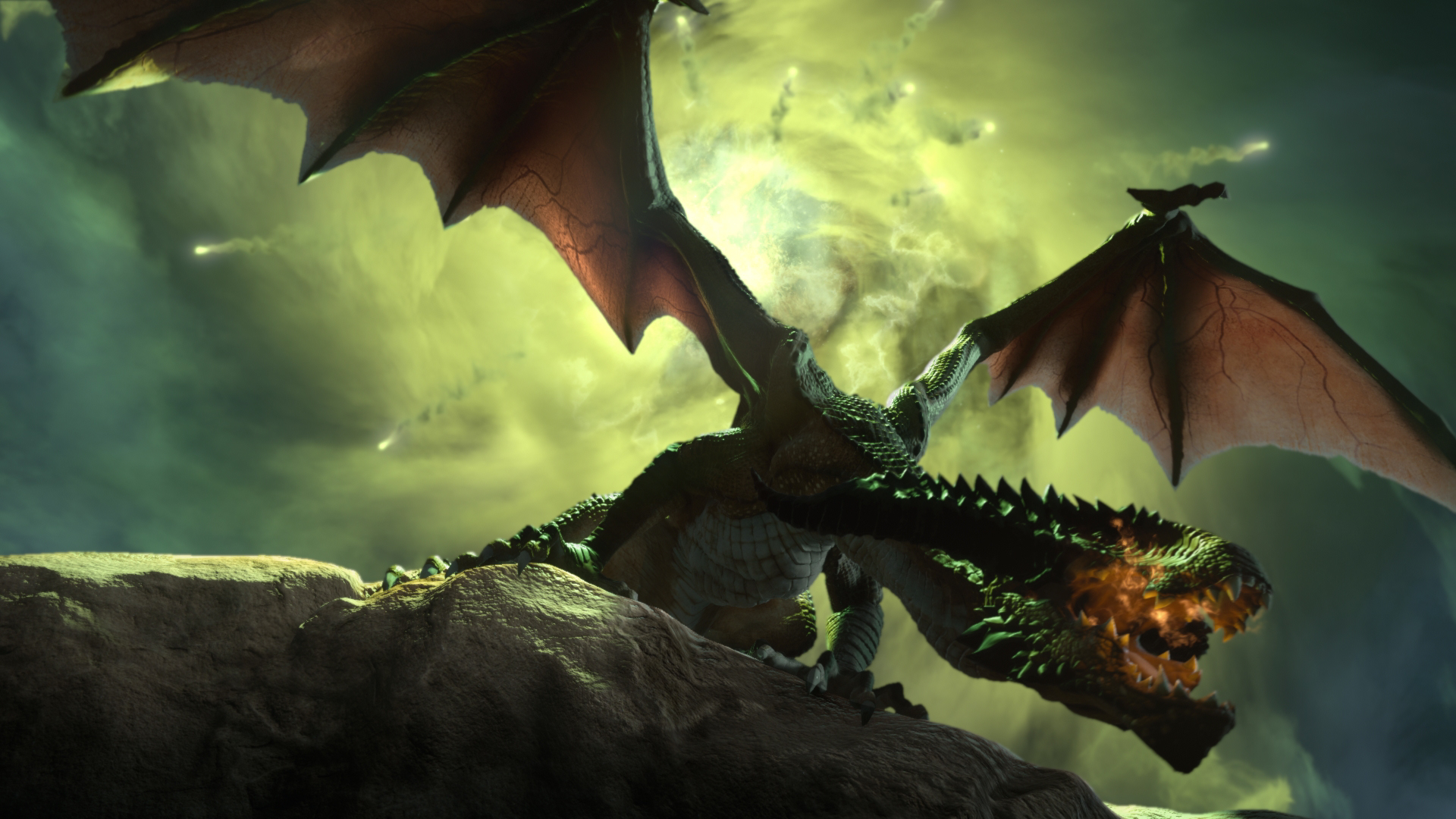
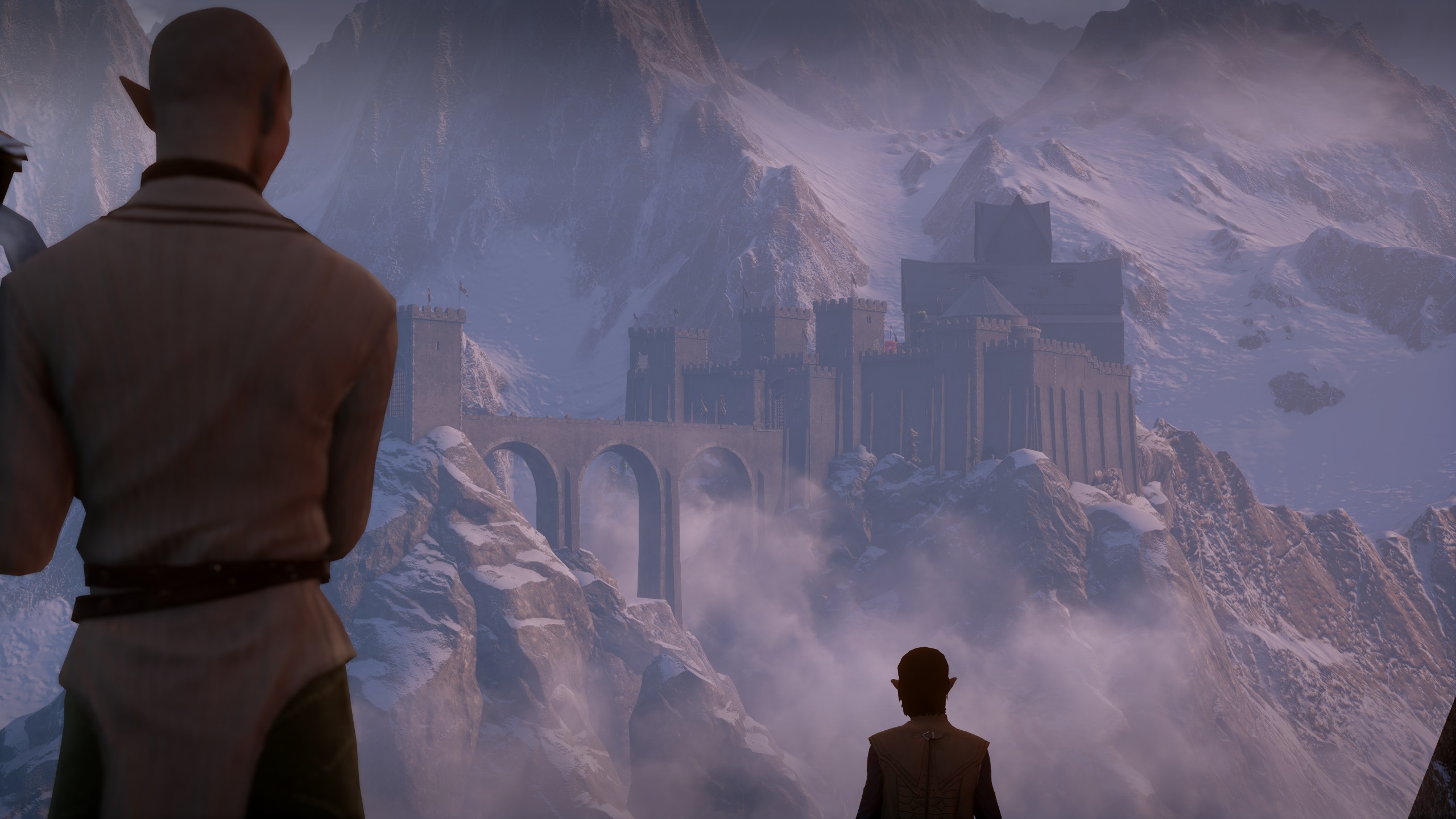
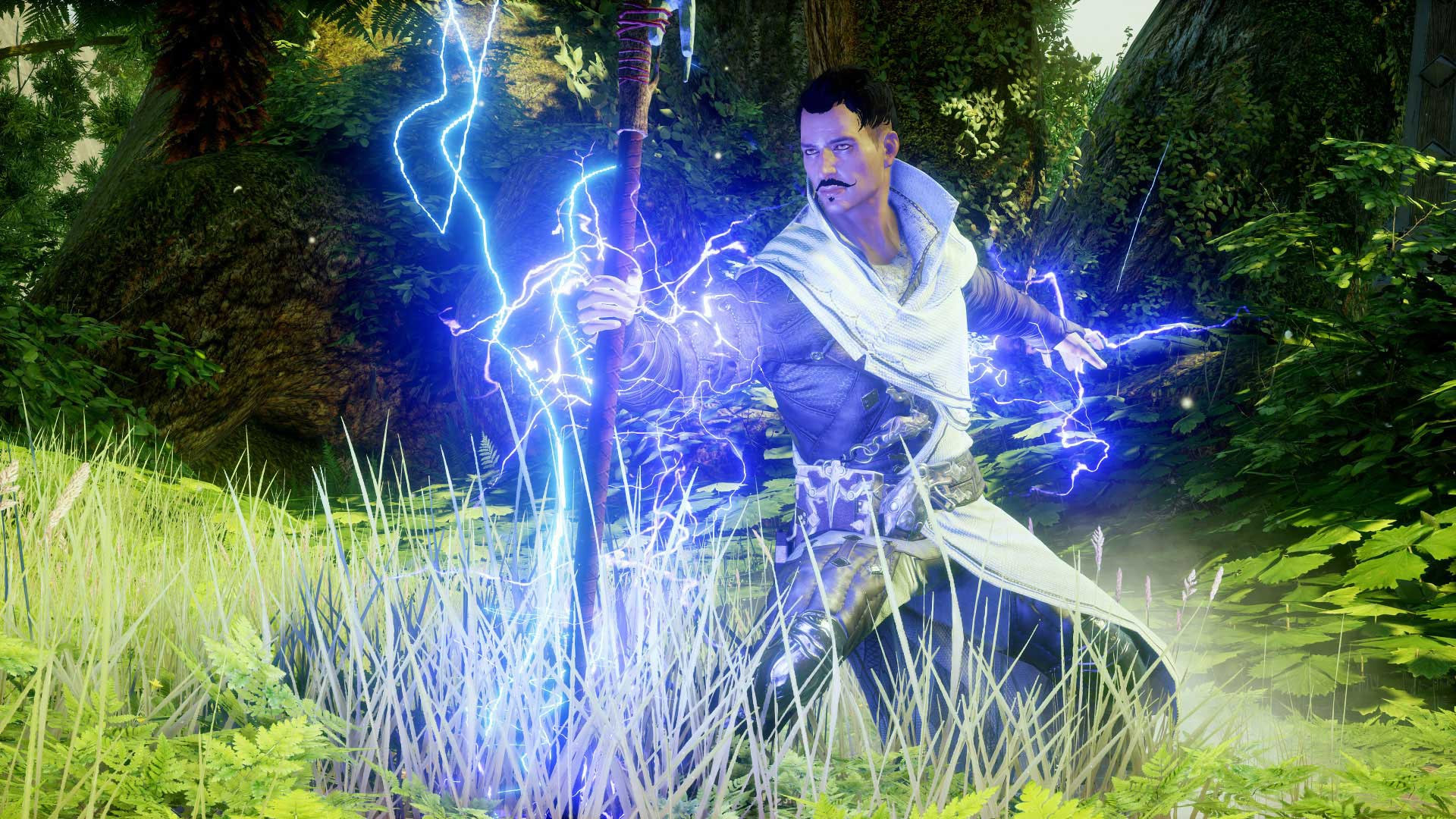
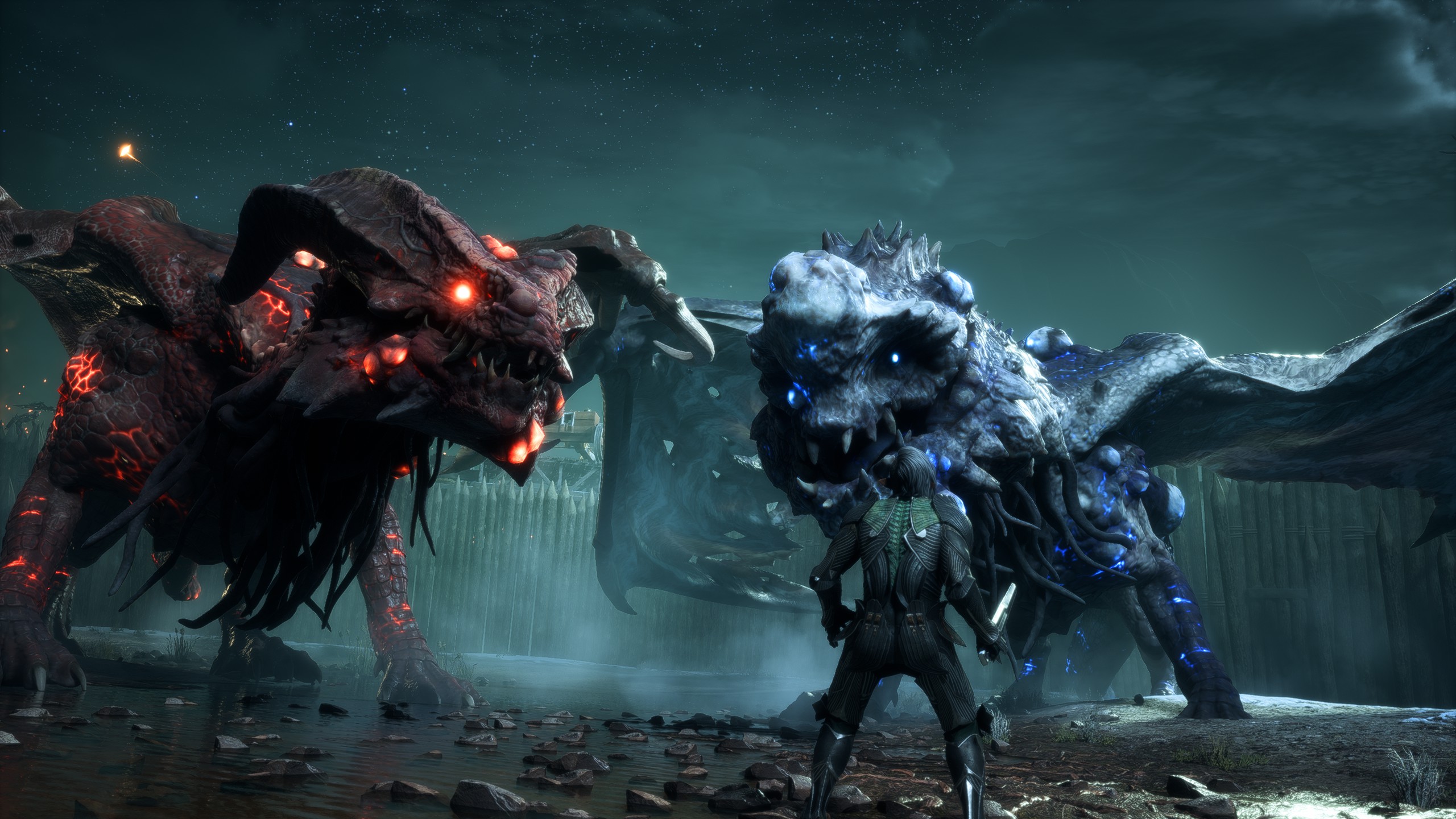

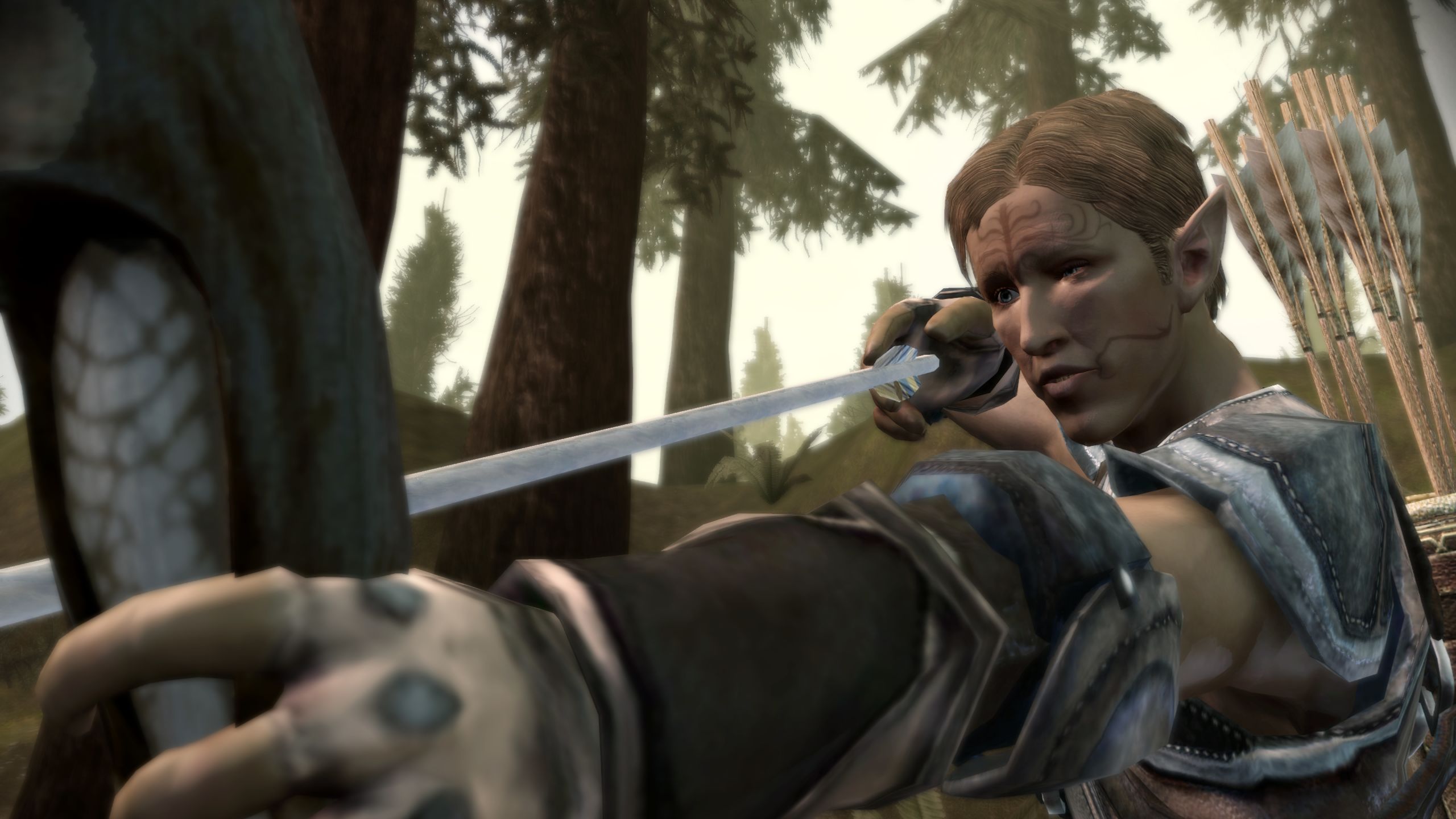
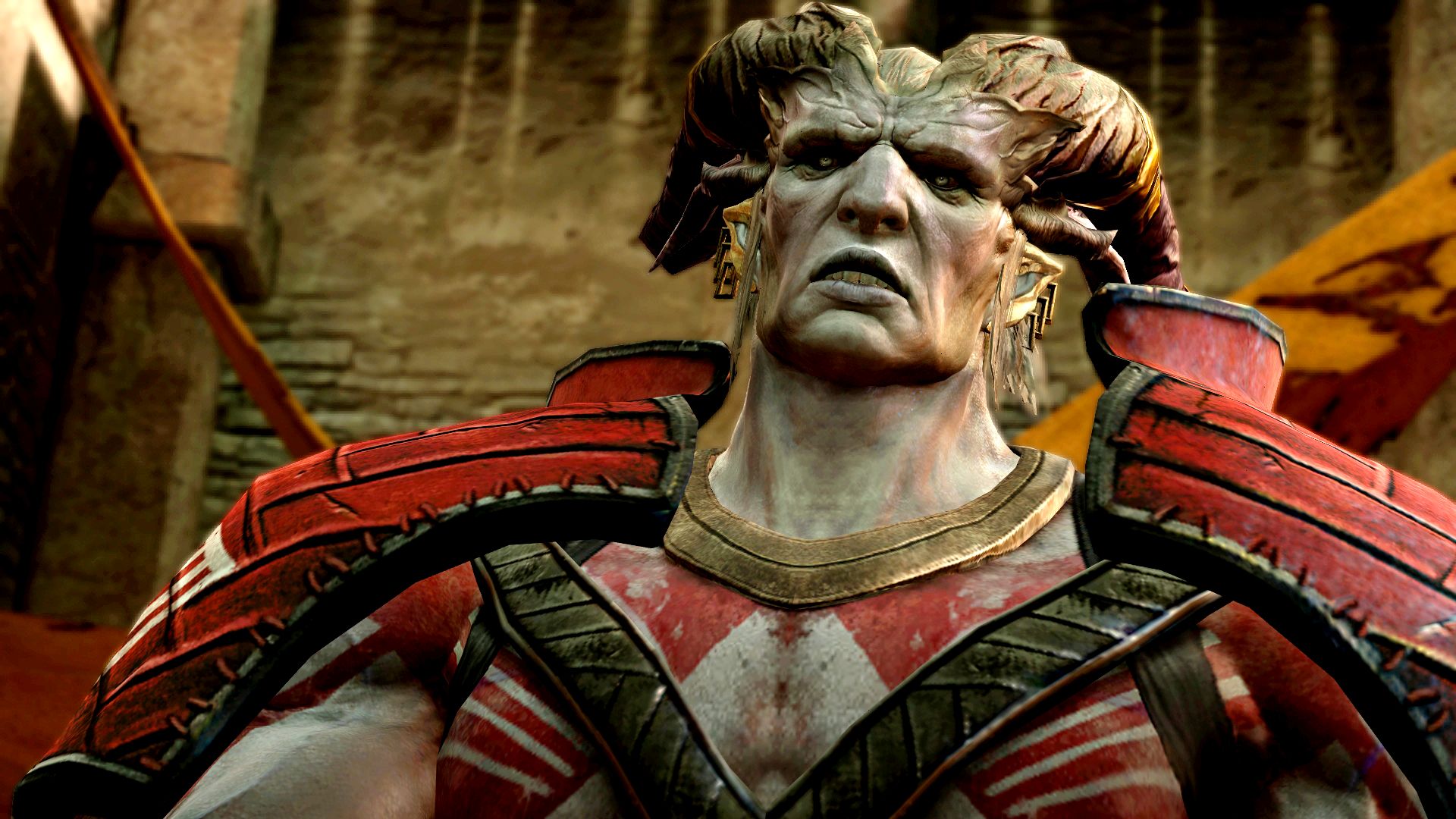
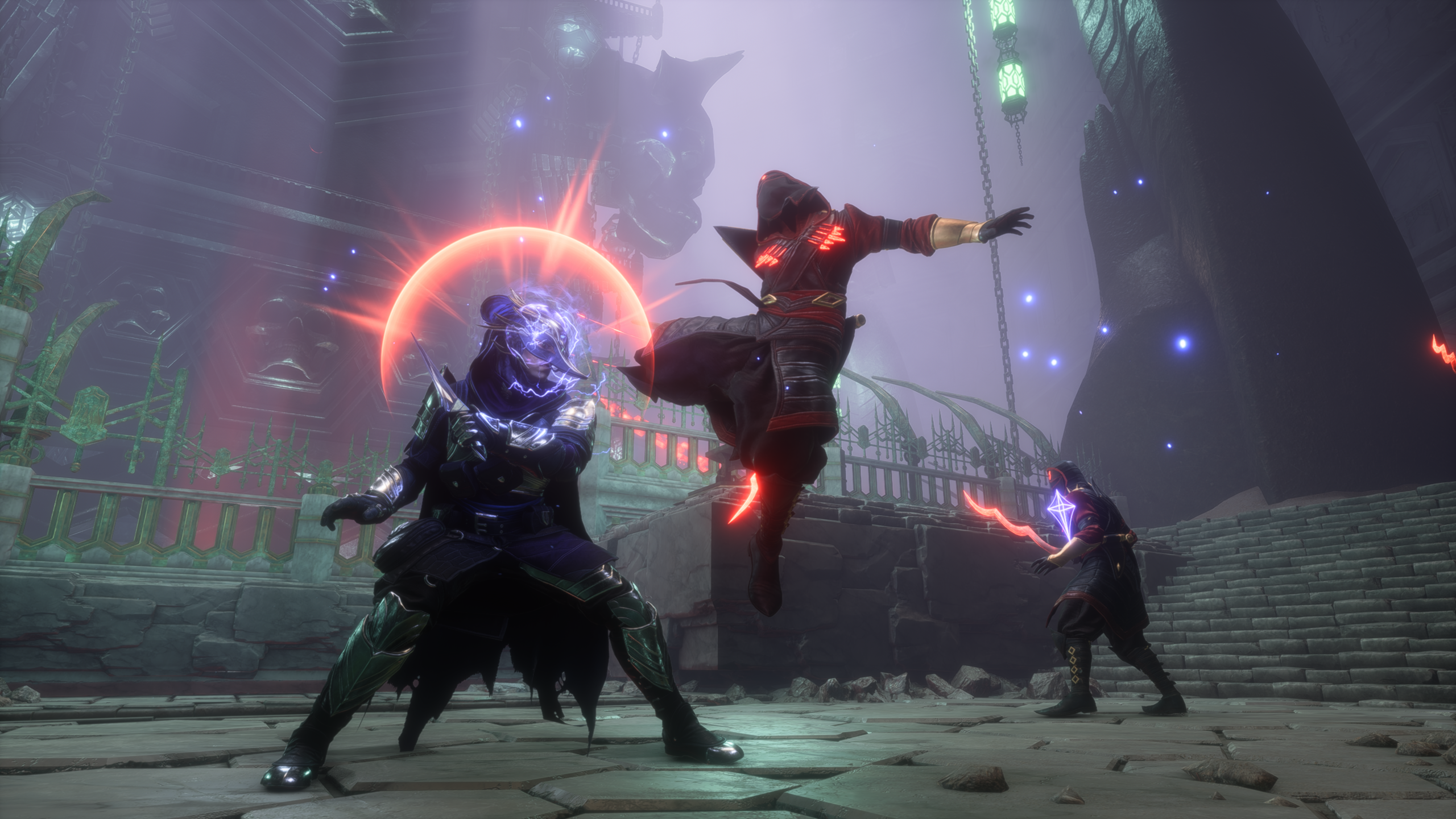
Dragon Age is celebrating its 15th birthday, a mere week after the launch of the fourth game in the series, Dragon Age: The Veilguard. It’s a geologically short period of time, but for videogames it might as well be a century, and much about the series has changed since we first stepped into the muddy boots of one of the last surviving Grey Wardens back in 2009.
This marked BioWare’s shift from D&D RPGs, like Baldur’s Gate and Neverwinter Nights, to a universe of its own creation. The name and first screenshots, released in 2004, suggested something quite traditional, though. Dragons, a bare-chested warrior, a busty mage in a crop top—oof. But eventually BioWare landed on a more distinct vision for its most successful series.
Dragon Age: Origins
I don’t remember if the first decade of the 2000s was particularly bleak—I don’t remember much about my 20s, period—but that was certainly the tone a lot of the videogames of the time tried to capture. Frequently in shades of grey and brown. Gears of War really typified this, but it extended far beyond games about muscle-bound super soldiers. Even BioWare was going grim.
EA’s marketing team decided to introduce people to the world of Dragon Age: Origins via a trailer that was desperate to appear adult and edgy, featuring buckets of blood and gratuitous violence. In between all the gore and murder, we got a tease for the Morrigan sex scene. We didn’t know the character, but already EA was trying to sell us on the game by pointing at her and saying “Look, you can have sex! Exciting!”. It was a far cry from Neverwinter Nights, BioWare’s previous fantasy RPG.
Of course, this proved not to be remotely representative of the actual game. Origins was a mature RPG, certainly, but not simply because it featured sex and violence. It dealt with challenging themes, like the relentless bigotry faced by the elves—which you could experience first-hand in the city elf origin—and the dwarven caste system. Intolerance was rife, even when it came to magic, which was presented not as this normal and accepted thing as it is in the Forgotten Realms, but rather a terrifying threat. The danger posed by magic inspired Thedas’s dominant religion, Andrastianism, to force mages to join an institution where they were constantly watched by the zealous Templars—warriors who were trained to kill any mage who might turn into an abomination.
It was an RPG absolutely brimming with coups, betrayals, wars and the clash of politics and religion. A broken world you could take advantage of, if you were of the more villainous persuasion, but also save. But yes, you could also sex up your companions and after every battle you’d be covered head to toe in blood—which inadvertently made a lot of dialogue scenes hilarious.
Most of the game’s origin stories—prologues that provided context for your character, with effects that cropped up throughout the game—were tragedies, and things didn’t get much brighter from there. BioWare filled Ferelden with gloom and horror in countless little ways, and all the while you’ve got this world-ending threat bearing down on you: the Blight, and an unstoppable legion of darkspawn. It was apocalyptic, but even with those huge stakes, it was never flashy. Thedas felt like a grounded world, where much of its darkness was uncomfortably mundane.
Despite some high fantasy themes, Origins never got carried away. Most conflicts were resolved by sharp swords rather than kaleidoscopic spells, and while there was a lot of talk of gods and archdemons, the former don’t make an appearance and the latter is consigned to an endgame threat. Thus, even with the presence of fantasy races, Ferelden is mostly evocative of medieval Europe: plague-ridden and impoverished. Filled with horrors, certainly, but not ones that were so fanciful that they became unrecognisable.
Visually, it was understated, with a muted colour palette and no-nonsense character designs. You could see BioWare trying to veer away from D&D after years of playing with the Forgotten Realms. This may have also informed the game’s approach to elves, which was very non-traditional. Rather than being the mystical, haughty fey beings that they are presented as in Lord of the Rings, and all the media inspired by it, here they are downtrodden and live on the fringe.
While the marketing was weird, Origins showed BioWare firing on all cylinders: a confident, distinct fantasy RPG more than capable of telling complex, nuanced stories even while it was trying to spin a yarn about a magical apocalypse.
Dragon Age 2
Only a year after 2010’s Awakening expansion, Origins got a sequel. Dragon Age 2 was a pretty significant departure from its predecessor. The combat system felt more inspired by console RPGs than the tactical CRPG-style system that served Origins so well, origin stories were gone, a singular voiced hero was in, and instead of traipsing all over a country our adventures were mostly confined to the city of Kirkwall and its surrounding environment.
We waited seven years to get our hands on Origins, but BioWare had to create Dragon Age 2 in little over a year. With that in mind, it was an impressive accomplishment, and the shrunken scope actually served it well—less so, the recycled dungeons. But the story was a doozy, focusing on the trials and tribulations of Kirkwall, and the band of buddies trying to solve its myriad problems.
The threat of the Blight and darkspawn was still present, but Dragon Age 2 also doubled down on the conflict between the mages and the Andrastian church, the Chantry, as well as introducing a new wrinkle: the qunari. While Origins had given us a taste of the qunari through our companion Sten, Dragon Age 2 gave us our first proper introduction to the now-horned and highly-advanced militant fundamentalists. The qunari begin as not-particularly-welcome visitors to Kirkwall, but thanks to DA2’s long time frame (it takes place over the better part of a decade) we got to see the relationship between these warriors and the town break down, devolving into conflict and conquest.
So while the scope had changed, BioWare’s storytelling ambitions had not. Navigating the fraught political situation in Kirkwall was no minor task, and the game was steeped in tragedies both personal and broad. And through the decade spent in Kirkwall, you got to see how your influence transformed it, and how its most important players were shaped by the passage of time, sometimes for the better, but often for the worse. It’s not a cheery romp, that’s for sure.
Like Origins, though, BioWare managed to elicit some lightness from the game’s wonderful cast of companions, the greatest of which had to be Varric, a not-entirely-trustworthy dwarf who also served as the game’s unreliable narrator. This storytelling conceit gave us some great moments, like when Varric outright lies to his interrogator—Cassandra, who we’d get to know a lot more a few years later—kicking off a scene where he defeats a mansion full of enemies solo, without breaking a sweat.
The change between Origins and DA2 remains controversial, but while the structure and mechanics of DA2 set it apart from Origins, the setting and tone felt entirely cohesive. Using Origins as a foundation, BioWare was developing a rich and unique fantasy world that eschewed the trappings of high fantasy. DA2 launched a month before the first episode of Game of Thrones aired, and at the time this rather serious approach to fantasy, where politics, religion and all sorts of real-world problems enjoyed as much attention as magical misadventures, still felt fairly novel—at least in videogames.
Dragon Age: Inquisition
While the gap between Origins and DA2 was infinitesimal, BioWare took a bit more time with Dragon Age: Inquisition—though it was still an incredible turnaround by today’s standards. Inquisition arrived three years after DA2’s final DLC, chucking us back into Thedas in November 2014. And this time the changes were even more significant.
Where DA2 was small and focused, Inquisition was gargantuan and epic. Famously, players had to be told to leave the first area, the Hinterlands, before burning out, because the relentless sidequests, puzzles and collectibles could trap you there forever. EA, ever obsessed with trends, wanted an open-world game with some multiplayer, and while that could have been disastrous, BioWare found a way to placate its overlord without compromising its vision too much.
Inquisition’s massive regions had a lot of the trappings of open-world games, and plenty of throwaway quests, but these locations were still kept separate, and the open-world elements sat alongside the kinds of quests and stories that BioWare was best known for. The multiplayer mode, meanwhile, was shunted off to the side, and there’s a very good chance that you forgot it even existed.
Inquisition’s most compelling shake-up was the role you were given as the latest Dragon Age hero. Rather than a nobody who’d been thrust into the most important events of the day, Inquisition quickly put you in charge of the titular organisation, making you one of the most influential people in the world in a few short hours. Much of the game was focused on making you the boss, forging alliances and sending agents off on clandestine missions.
This influence also meant you had to split your focus a lot, worrying about all of southern Thedas, sending you on jaunts to sorrowful, wind-battered coasts; stunning elven forests; scorched deserts; and Orlasian palaces. The broader scope gave us a much better look at Thedas, but there was a cost: the world no longer felt cohesive. One minute you could be rooting around in gorgeous elven ruins while the sun shone through the leaves of impossibly massive trees, the next you could be fighting one of the game’s many dragons in the desert, or attending a fancy masquerade ball, or delving into the Deep Roads.
The result was a world that at times felt much smaller than it did in Origins. Instantly travelling across the length and breadth of southern Thedas, where each region had its own vibe and visual identity, made the adventure feel heavily segmented and occasionally jarring. It was missing the distinctiveness of its predecessors, lacking as it did a singular aesthetic or sense of place.
While BioWare’s storytelling skill was still on full display, it was also becoming clear that the studio was struggling to come up with interesting stakes when the very first game had already seen you face insurmountable odds, defeat an archdemon and end a Blight. DA2 sidestepped the issue by taking place during the same time, telling a parallel but more personal story. Inquisition was unable to, though, and instead stumbled into some difficulty by putting the focus on a rather generic villain who you freed from captivity in some DA2 DLC.
In characters like Loghain, the Arishok and Meredith we got nuanced villains who were sometimes even sympathetic. They believed the awful things they did were necessary, justifying their deeds under the maxim of the greater good. Inquisition’s Corypheus, though, was just a pantomime villain. A power-hungry mage who wanted to be a god. And only you can stop him, because you’ve accidentally come into possession of the power to close the rifts in the Veil, from which demons have been pouring out. Between the scenery-chewing darkspawn mage, the massive green tear in the sky, and the world looking to you to save it, the grounded fantasy that BioWare had cultivated was under threat.
Inquisition was exceptionally successful, though, and BioWare has continued to run away from the foundations it established in Origins. After a decade of waiting, we now have the fourth game, Dragon Age: The Veilguard, and by now the series has become nearly unrecognisable.
Dragon Age: The Veilguard
Inquisition represented a middle ground between action-RPG and CRPG, a mix of Origins and DA2, but The Veilguard has firmly picked a side. It fully embraces action, to the point where you don’t even have direct control over your companions—only two of which you can bring with you at a time, compared to the three in previous games—who serve as invincible additions to your powerset rather than proper party members.
These companions also don’t have much agency. Previous games have forced us to deal with their ulterior motives, betrayals and bickering, but the cast of The Veilguard is made up of just some nice people who mostly get along really well. One little bit of friction between Davrin the Grey Warden and Lucanis the possessed assassin amounts to some slightly barbed words and nothing else. They’re pals again in the next cutscene. And that’s treated as a serious fracture in the team.
A lack of friction is one of the biggest differences between The Veilguard and the rest of the series. One of the factions you work with—and which you can be a part of—is a group of assassins for hire, but not one of the do-gooders populating the world has the slightest problem with that. You even get to crack jokes about literally murdering people for cash and it’s just waved away. You’re never treated like anything other than a classical hero.
Like a lot of action-RPGs, The Veilguard is more concerned with getting you into the next cool moment or scuffle rather than letting you develop your character. While every game from Origins to Inquisition is rife with moments where you must stress out over one decision or another, The Veilguard limits its meaningful choices to just a few, leaving only rare opportunities to question yourself, and no arguments with any of your loyal crew. It’s a smooth, wrinkle-free fantasy romp—and that extends to the world itself.
While The Veilguard has largely dropped the open-world elements of Inquisition, the scope remains broad, encapsulating all of northern Thedas, but there’s little interconnectivity, even in the areas that sit right next to each other geographically. The way you just flit between them, travelling via magical mirrors, undermines the sense of scale. Everywhere is right at your doorstep, making Thedas feel tiny.
Where Inquisition started to veer towards glossy high fantasy, The Veilguard dives headfirst into it. It’s bloodless and bright, full of magical spectacle, ancient technology and floating citadels. In this sense, I suppose, The Veilguard is a bit more cohesive than Inquisition, which had a foot in both the grounded fantasy of Origins and the more fanciful, over-the-top stuff BioWare used to muck around with when it was still making D&D adaptations.
Still, it’s a bit jarring to go from muddly, grimy dark fantasy to this generically beautiful world where everyone is walking around in over-designed haute couture, and where your HQ is a ruined palace floating in the world of spirits. Go big and go showy seems to be its mantra. You’ve got two gods to deal with this time; a new Blight, with mutated darkspawn to boot; and revelations that entirely change everything you know about elves, dwarves and the Veil. Everything is exaggerated, no opportunities for a big set piece go ignored, and there’s just not much time for meditations on morality or politics.
The vibe is Rings of Power meets the MCU: flashy, epic, forgettably pretty and massively codified. But for an action-RPG, it ticks a lot of the right boxes. Lots of brisk fights where you get to feel like a super-powered badass, skill trees it’s easy to build your character around, a mostly straightforward plot that you don’t need to mull over, and you get to beat up a bunch of dragons.
If it wasn’t already quite obvious, I’m not really a fan of how Dragon Age has evolved over the years, and my ranking of Dragon Age games would simply be the order in which they were released in—though I do think DA2 features the strongest writing of the series. But that doesn’t mean I always subscribe to the idea of “If it ain’t broke, don’t fix it”. DA2’s smaller scope absolutely made it a better sequel, changing focus instead of trying to one-up its predecessor. And BioWare’s choice to make you the leader of a massive organisation in Inquisition was inspired—almost entirely making up for the fact that it didn’t have a decent antagonist. As much as I’ll always just want more Origins, Dragon Age’s malleability has always been a strength, even if I think it’s completely lost its way with The Veilguard.

